| |
Nevada - the Silver State |
| Click the points of the map below to learn more

|
| |
 |
Located in the Mojave Desert, Las Vegas was incorporated as a city in 1911. No city in the United States has experienced more growth in the 20th century than Las Vegas. It is the largest city in Nevada and 29th largest city in America.
Las Vegas is well known as the nation’s top gambling destination and one of the top tourist destinations in the entire world. It is often referred to as the "entertainment capital of the world" for its many casinos, theaters, shows, restaurants, and flashy hotels.
Las Vegas was established in 1905. It is the most populous American city founded in the 20th century. In 1931, the state of Nevada legalized gambling and passed laws easing restrictions on divorce, which would attract thousands from other states where divorce laws were very strict. In addition, construction on the Hoover Dam began brought thousands of worker
Back to Map
|
| |
|
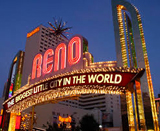 |
Reno
Reno was founded in 1868 as a depot on the Central Pacific Railroad after gold and silver were found in west Nevada. The town was named after General Jesse Reno, a Union general killed in the Civil War. Reno soon flourished as the largest stop on the Transcontinental Railroad between Salt Lake City and Sacramento. The city would next become a major mining and gambling center.
Today, Reno is the largest city in central Nevada and remains a popular gambling destination. It is sometimes referred to as the "The Biggest Little City in the World." It was the birthplace of Caesar’s Entertainment, a multinational corporation that owns casinos, hotels, and golf courses.
Back to Map |
| |
|
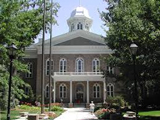 |
Carson City
Like Many of Nevada's towns, Carson City was founded during the gold and silver mining boom of the 1850's and 1860's. The city was named after American frontiersman Kit Carson. Miners and Prospectors flooded to the hills around Carson City after the discovery of the Comstock Lode, the largest concentration of silver in the world, in nearby Virginia City. Carson City was named capital of the Nevada territory in 1861.
Back to Map |
| |
|
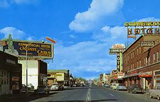 |
Elko
Elko, Nevada was founded in 1869 after the Central Pacific Railroad extended its tracks to the region. Although the origin of the name "Elko" is uncertain, most believe the city is named after the resident elk in the region.
Today, Elko is a stronghold of western culture. It is home to the National Cowboy Poetry Gathering, the Western Folklife Center, as well as a number of casinos.
Back to Map |
| |
|
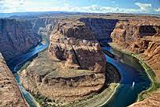 |
Colorado River
| Length: |
1,450 miles |
| Source: |
Rocky Mountain National Park |
| Outflow: |
Gulf of California |
| |
|
| The mighty Colorado River, which eventually flows through several national parks before carving the Grand Canyon, starts as a narrow stream near Lake Granby in Colorado's Rocky Mountain National Park. |
Back to Map |
| |
|
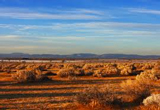 |
Mojave Desert
The Mojave desert extends through southern Nevada, northwestern Arizona, and parts of southeastern California. The region gets about six inches of rainfall per year. Most of the desert is between 3,000 and 6,000 feet in altitude. Summers are extremely hot. Some places, like Death Valley, regularly reach temperatures of 120 degrees Fahrenheit.
The Mojave is one of the most biologically rich deserts. About 2,000 species of plants have been documented.
Back to Map |
| |
|
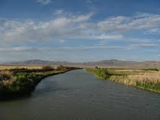 |
Humboldt River
| Length: |
300 miles |
| Source: |
East Humboldt Range, Nevada |
| Outflow: |
Humboldt Sink |
| |
|
| The Humboldt River is the longest river in the Great Basin Region. It served as part of the primary route that led prospectors to the California gold mines in the 1800's. In 1869, the river was used as part of the route of the Central Pacific segment of the Transcontinental Railroad. |
Back to Map |
| |
|
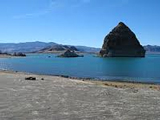 |
Pyramid Lake
Pyramid Lake, located in the Great Basin region of Nevada, is a large saline (salt-water) lake. It is the last remnant of the ancient Lake Lahontan, which once covered much of northwestern Nevada toward the end of the last ice age. Pyramid Lake was the site of several violent encounters between white settlers and the Northern Paiute in 1860, known as the Pyramid Lake War. As many as 80 settlers were killed in the skirmishes.
Back to Map |
| |
|
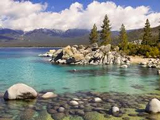 |
Lake Tahoe
Lake Tahoe is a freshwater lake on the California/Nevada border. It is the second deepest lake in America. At an altitude of 6,229 feet, it is also one of the highest.
The lake is an extremely popular tourist attraction. Thousands of people come to Lake Tahoe every year to enjoy the excellent skiing, sledding, hiking and water sports activities. In addition, there are casinos on the Nevada side of the lake.
Back to Map |
| |
|
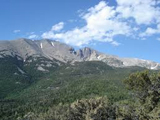 |
Great Basin National Park
Great Basin National Park, located in eastern Nevada, highlights the area known as the Great Basin, a high mountainous region between the Rocky Mountais and the Sierra Nevada Mountains.The park is best known for its
collection of bristlecone pines, twisted looking evergreens that are thought to be the oldest living things on the planet. Some may be more than 4,000 years old.
Back to Map |
| |
|
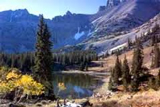 |
Great Basin
Encompassing the entire state of Nevada, and much of Utah, Idaho, and Oregon, the Great Basin is an arid, mountainous area in the western United States, between the Rocky Mountains and the Sierra Nevada Range.
It consists of a series of mountain ranges in Nevada including the East Humboldt, Ruby, and White Mountains. The basin itself is a series of watersheds with no outlet to the sea or to a river that flows to the sea. Any precipitation that falls evaporates, seeps into the ground, or forms playas, short lived lakes that eventually evaporate.
Back to Map |
| |
|
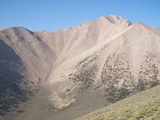 |
Boundary Peak
Located in the White Mountains of western Nevada, Boundary Peak is the state's highest point at 13,441 feet.
Back to Map |
| |
|
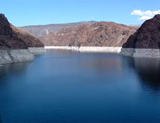 |
Lake Mead
Lake Mead is the largest manmade reservoir in the United States. It was formed by water impounded from the Colorado River by the Hoover Dam. The water from Lake Mead serves residents in southern California and Nevada.
In 1964, Congress established Lake Mead National Recreation Area. Nearly ten million people visit the park every year!
Back to Map
|
| |
|
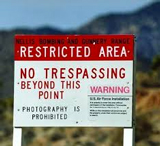 |
Area 51
Area 51 is a mysteroius region in southern Nevada that is said to be a testing facility for secret, military airplanes. It is also at the center of UFO conspiracies. Many believe the area serves as a storage area for downed alien spacecraft, or, as a laborotory for experiments on dead aliens. As a result of such rumors, Area 51 has played prominently in film and media.
Back to Map |
| |
|
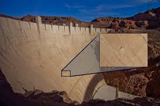 |
Hoover Dam
The Hoover Dam can store 9.2 trillion gallons of water in its reservoir, Lake Mead. It was named after president Herbert Hoover. The Hoover Dam was built for three reasons:
| 1.) To stop flooding caused by melting snow. |
| 2.) To enable irrigated farming in the desert region. |
| 3.) To provide water for southern California. |
Back to Map |
|
| |
Nevada State Bird |
| |
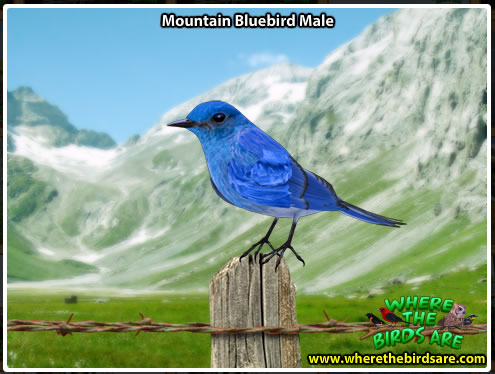
Nevada State Bird: Mountain Bluebird |
Top Five Facts |
| |
1. ) Despite being called the Silver State, Nevada is the nation's leading producer of gold, producing more, in fact, than California, "the Golden State." |
2. ) Las Vegas, Nevada has more hotel rooms than any other city on Earth. |
3. ) About 85% of land in Nevada is owned by the U.S. Government. |
4. ) Carson City is one of only two capital cities that border another state. |
5. ) Nevada is the driest state in the nation, averaging seven inches of precipitation per year. |
| |
|
| |
 |
| |
| Nevada Settlement Postage Stamp |
| |
|
1542: Spanish explorer Juan Rodriguez Cabrillo explores and names the area Sierras Nevadas.
1609: The town of Santa Fe was established as a Spanish-Indian trade center.
1826: Jedadiah Smith is reported to be the first "White" man to enter Nevada.
1829: Modern-day Las Vegas (Spanish for "The Meadows") is named by explorers on the Old Spanish Trail. The travelers found an abundance of water in the region that enabled a trail to Los Angeles.
1833: John C. Fremont and his party discover Lake Tahoe.
1846: The Infamous Donner Party became trapped in the snows of the Sierra Nevadas and resorted to cannibalism to survive.
1848: United States acquires Nevada as part of the Treaty of Guadalupe-Hidalgo, as a result of the Mexico War.
1849: First recorded discovery of gold in Nevada was in Gold Canyon near present day Dayton.
1851: Carson City is founded as a trading post.
1859 - 1878: Comstock Silver Load discovered in Virginia City. Thousands of prospectors descend upon the "boomtown." Over $400 million of silver and gold is extracted from the region marking the nation's first major silver deposit discovery. Wealth from the Comstock Load greatly contributed to the growth and development of San Francisco, California and Nevada.
1861: Nevada separates from the land referred to as "Utah Territory" and adopts the name Nevada.
1864: Nevada becomes the 36th state.
1935: Construction on the Hoover Dam begins attracting thousands of workers from across the country and likely fueling the propagation of legal gambling.
1951: The Nevada Test Site is built for the purposes of testing Nuclear Weapons.
|
|
|

















